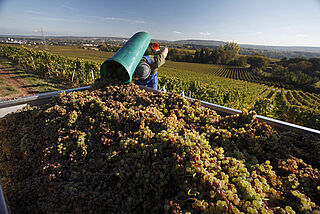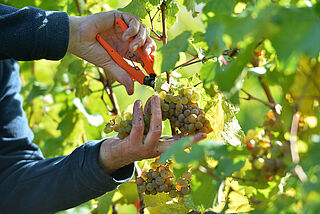Details
2021 – A vintage of good wine quality in Germany
A lot of work and patience
"The winemakers gave it their all this year and largely coped well with the major challenges that came, in particular with the abundant rainfall," explained DWI Managing Director Monika Reule. After extensive plant protection measures over summer, the high workload in the vineyards continued until the grape harvest, which began relatively late. In order to obtain healthy grapes, a lot of pre-selection work was done by hand and patience was required to allow the grapes to ripen for as long as possible. For the later ripening varieties such as Riesling, the harvest lasted until the end of October and will continue into November for some wineries.
Aromatic and lean wines
This year's later harvest had the advantage that the aromas in the berries could be particularly well developed during the warm autumn days and cool nights. The 2021 wines are correspondingly rich in fruit. They are also much leaner than in the last very warm years and have a fresh, lively acidity.
Large regional differences in yield
The yield situation varies greatly from region to region this year. Depending on the microclimatic conditions and the success of the phytosanitary measures, the harvest quantities within a growing region range from "extremely low" to "extraordinarily good".
The differences in yield are also relatively high among the growing regions. On the Middle Rhine and in Franconia, for example, very good yields are expected, which are around a third and twelve percent respectively above the long-term average. In Baden, on the other hand, late frosts caused major yield losses, especially in the south of the region, so that a decrease of 20 percent is expected for the growing region compared to the average of the last ten years. Reduced yields of fifteen and ten percent are also reported from Saale-Unstrut and the Nahe.
Good yields in the Ahr
In the other German winegrowing regions, must yields are expected to be about the same as the respective average yields. The winegrowers in Württemberg are pleased with an average yield that, despite late frost and hail damage, is significantly higher than the exceptionally small 2020 harvest. The same applies to the growers from the Ahr, who were able to bring in an estimated harvest of 39,000 hectolitres thanks to the great helpfulness and solidarity of countless volunteers.
European harvest volume in the red
In view of a comparatively small European wine must harvest in 2021, which according to the EU Commission's estimate of 171 million hectolitres will probably be 13 percent smaller than in the previous year, German wine producers see themselves in a relatively good starting position on the domestic and international wine market with their harvest results.
Forecast of the 2021 German wine must harvest
|
Estimate as of October 27, 2021 |
||||
|
2021 |
2021 |
2021 |
||
|
Wine Region |
Average yield 2011-2020 |
Estimated grape harvest quantity |
Change compared to 10-yr average |
Change compared to previous year |
|
hl |
hl |
% |
% |
|
|
Ahr |
38.000 |
39.000 |
2 |
24 |
|
Mittelrhein |
28.000 |
36.000 |
30 |
35 |
|
Mosel |
5 |
- 6 |
||
|
Nahe |
321.000 |
- 10 |
- 10 |
|
|
Rheinhessen |
4 |
1 |
||
|
Pfalz |
1 |
- 3 |
||
|
Rheingau |
3 |
- 4 |
||
|
Hess. Bergstraße |
32.000 |
5 |
- 8 |
|
|
Franken |
12 |
79 |
||
|
Württemberg |
1.000.000 |
1 |
34 |
|
|
Baden |
1.222.000 |
977.000 |
- 20 |
- 11 |
|
Saale-Unstrut |
44.000 |
38.000 |
- 15 |
27 |
|
Sachsen |
23.000 |
22.000 |
- 2 |
5 |
|
Germany |
8.865.000 |
8.733.000 |
- 2 |
3 |
Source: DeStatis, DWV-Estimate
Terug Print


